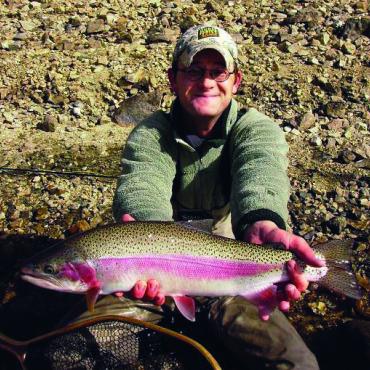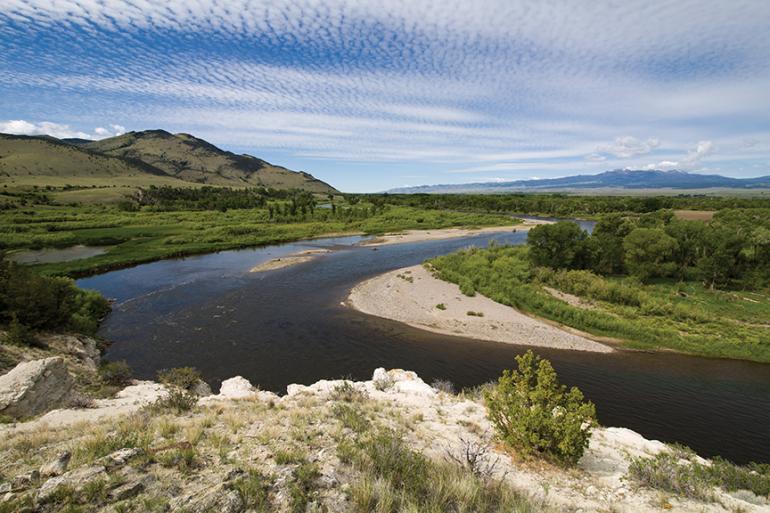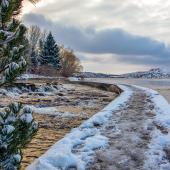The Jefferson River
A trout-chaser's delight.
The Jefferson River is the shortest (83 miles) of the three tributaries that make up the Missouri. From its source near Twin Bridges to its confluence with the Madison at Missouri Headwaters State Park, the Jefferson is one of the primary water sources for this section of the state. Over recent years, the Jeff has had its share of troubles due to drought and irrigation dewatering, with some sections dwindling to just a trickle. However, due to the heroic actions of ranchers and conservationists, this river is on a steady comeback. With proper planning and preparations, there can be some fantastic fishing on the Jeff.
Access
The Jefferson River corridor runs along state highways, but passes primarily through private land. However, there are 10 Fishing Access Sites (FAS), seven of which have boat ramps, three of which are paved. The Jefferson River Canoe Trail offers several hand launches with campsites, but these may or may not be useable depending upon type of watercraft, trailer, and river conditions. Many of the access sites provide wading access as well, but be aware—there are some very deep runs walled off by steep banks on this river.
Flows
The flow of the Jefferson is so varied it is nearly impossible to pull together an actual average. Low and frigid during the winter months, it can quickly turn into a raging torrent during the spring runoff. While the sweet spot usually occurs around the end of June, depending on snowpack, irrigation demand, and rainfall, flows can drop dramatically. Consult the USGS water data web site (waterdata.usgs.gov) for accurate daily flows. Keep in mind that even if the flows are good enough to float, the water temperature may be lethal for fish. During years of low flows and high water temperatures, Montana FWP will occasionally close some sections of the river.
When to Go
For the most part, the Jefferson is a three-season fishery. The pre-runoff spring season and the late summer / early autumn shoulder seasons are hands-down the best producers. However, if you ask any guide who has plied her waters, the Jeff can turn even the best fisherman from hero to zero in the span of a few hours. Locals tend to like the late fall fishing best, usually after the first freeze. Early spring and even mid-summer can also provide some stellar days, but good research is crucial to angling success. Fly shops, tackle dealers, even a few ranch-supply stores are great places to get information. Peg down several trustworthy reports before heading to the water.
Fish
Long known as primarily a brown-trout fishery, the Jefferson has recently seen a promising resurgence of rainbows. Thanks to the efforts of groups like Trout Unlimited, along with legions of concerned farmers and ranchers, the Jeff is steadily becoming a more diversified fishery. The fish in this river know every eddy, boulder, riffle, cut bank, and tail-out, and will behave in ways trout in other rivers do not. These trout will turn up in unlikely places—because the Jeff is big and wide, expect to do a lot of casting when prospecting for hookups. Due to comparatively low fish density, (700 to 800 fish per mile) the trout in the Jefferson can be on the larger side, but they can also seemingly disappear, leaving anglers with an empty net at the end of the day.
Row vs. Wade
The Jefferson is a big river. Deep, swift holes, some large slippery boulders, and sections of steep bank intimidate many prospective wading anglers. Some of the best wade fishing is done during the shallower seasons, upstream or downstream from an FAS. Due to the spread-out nature of the fish, floating is by far a better option. Drift boats, rafts, and canoes are usually the main means for float-fishing the Jeff. Many anglers will beach or anchor on a gravel bar to fish the more productive water by wading; this float-and-wade technique allows folks to push past some of the less productive stretches, while spending more time on “fishy” water.
Regulations
Fishing is closed from April 1 to May 1 and September 30 to December 1 within 100 yards of the mouths of Hells Canyon Creek and Willow Springs Creek. During some hot, dry years the state will put some sections under “hoot-owl” restrictions, or close them entirely. The trout limit is three daily, only one over 18 inches, and only one rainbow trout. Check the current FWP’s regulations booklet, or log onto fwp.mt.gov for up-to-date information.
Getting There
From the greater Bozeman/Belgrade area, the Jefferson can be reached in several ways. The most direct and closest route is via I-90 west to Three Forks, and then heading south by southwest on 287. The second route is farther west on I-90 via the Whitehall exit, and then south by southeast on Highway 55, which turns into 41 and will eventually take a traveling angler to Twin Bridges.
Hot Spots
As the water begins to warm, the trout will seek out cooler, deeper areas. Head toward the source in the heat, but as things begin to cool don’t neglect the water that may at first glance appear fishless. If one’s budget allows, hire a good guide—if they make their living on this river, they know how, when, and where to fish it. Since the fish can be so spread out, seeking advice when heading to the Jeff will help you make the most of your trip. Tackle shops and sporting-goods stores are good starting points, as well as some dedicated web searches.












